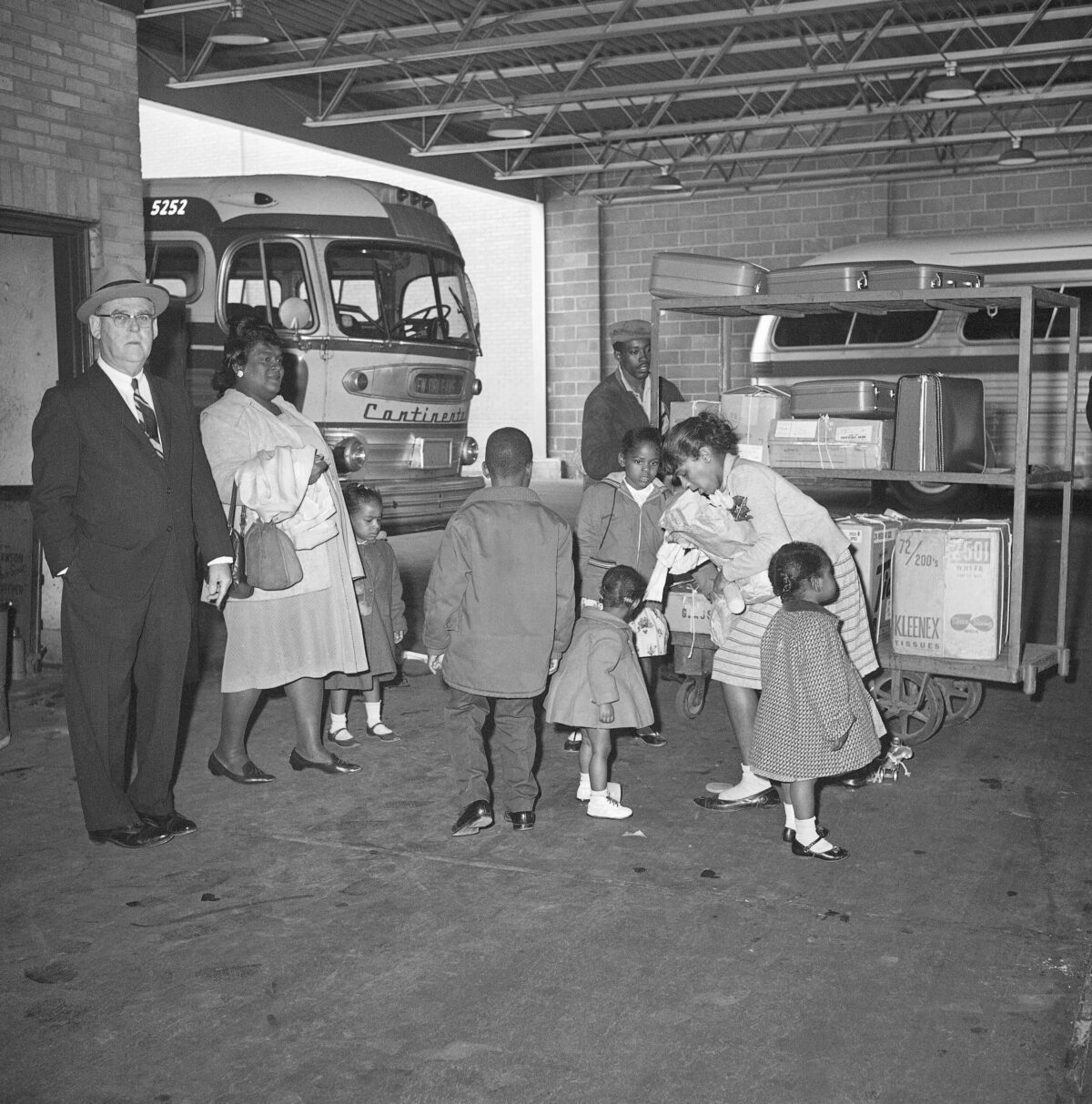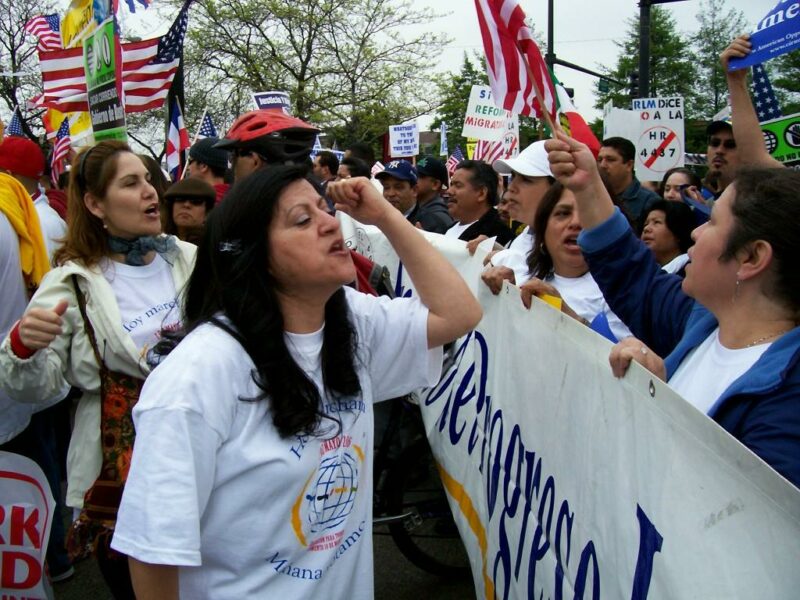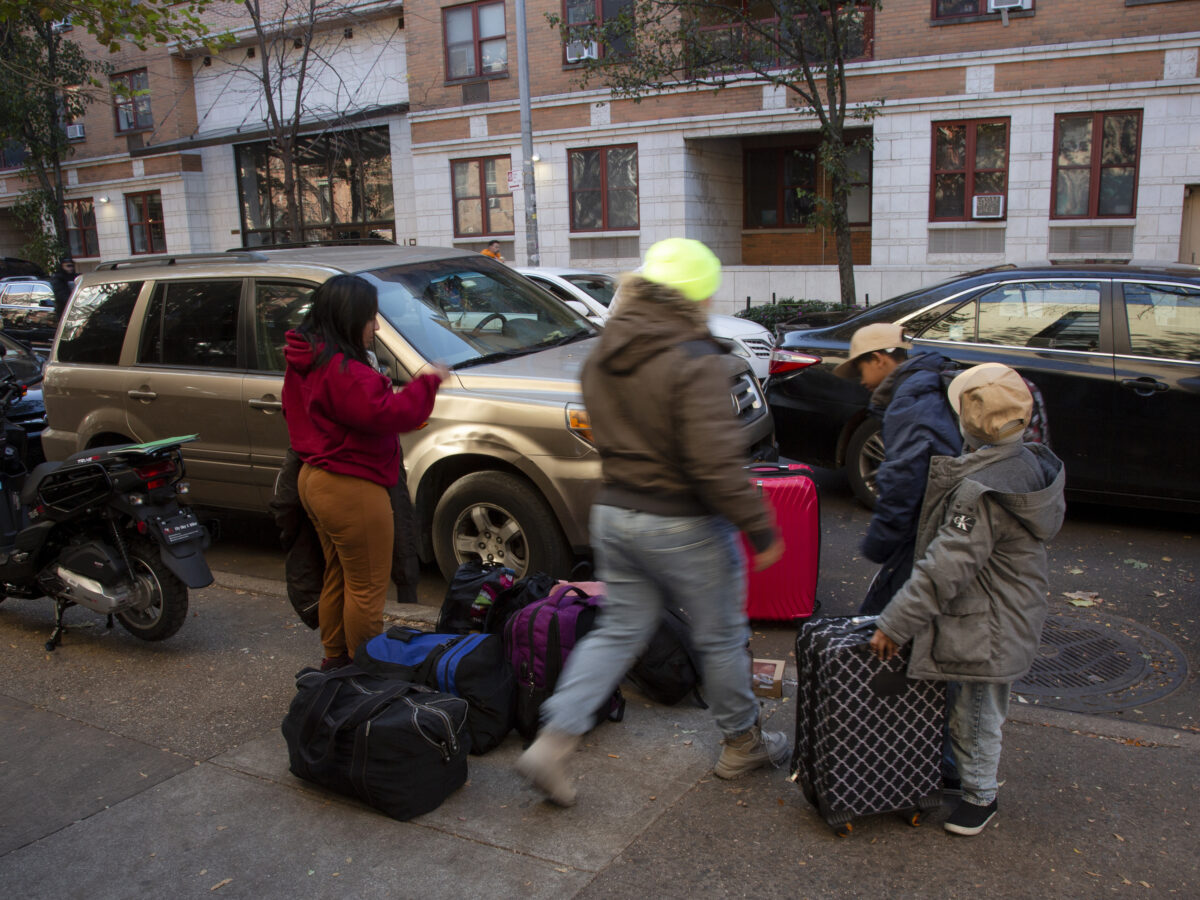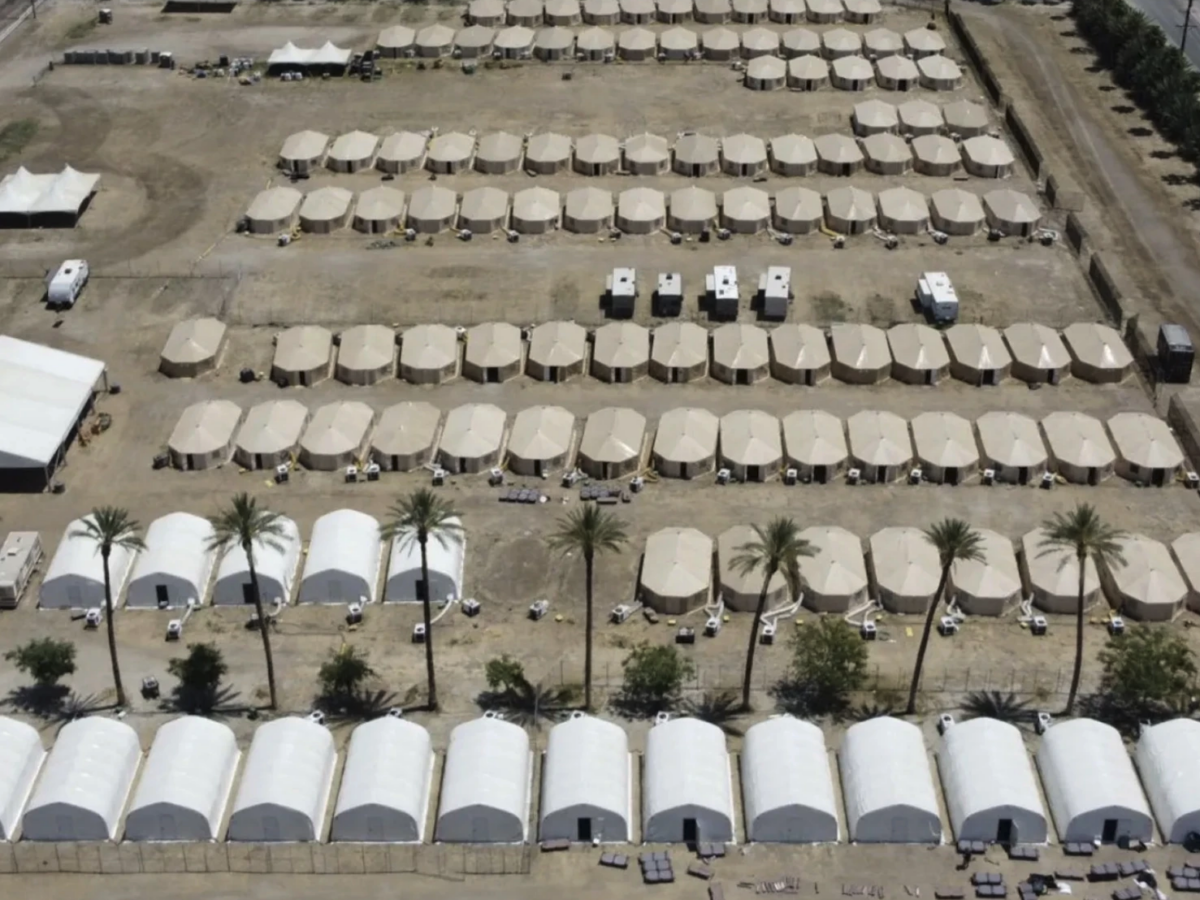It’s 1:15 at night, in the last week of December. A train comes to a screeching halt at a station on the South Side. A reporter on the scene describes it like this: “From the all-coach train came an assortment of human beings. Bewildered migrants who stepped out into sub-zero cold for the first time in their lives; small, sickly children, clad in tattered garments which were no match for Chicago’s bitter weather.”
It might sound like a typical scene from the last year of Chicago’s humanitarian crisis, as thousands of migrants arrived from Texas—but these are the words of reporter Lloyd General for the Chicago Defender in 1962 referring to Black families from the South.
The current humanitarian crisis is not the first time that Chicago has received an influx of migrants sent by Southern politicians. Today’s crisis is brought on by Republican Texas governor Greg Abbot in what he has called Operation Lone Star, with the participation of Republican Florida governor Ron DeSantis. But in the 1960s, Chicago and other Northern cities were targets of Reverse Freedom Rides, orchestrated by George Singelmann of the Greater New Orleans chapter of the white supremacist and segregationist White Citizens’ Council.
Both campaigns had the same goal: to strain the city infrastructures of political opponents by sending hundreds of migrants. Both used destitute people as pawns in a political scheme, and both exposed cracks in the cities’ ability to assist migrants as well as their own populations.
The Reverse Freedom Rides of 1962 originated as a pro-segregationist public relations campaign. For about a year, from April 1962 to early 1963, the Councils in New Orleans and Little Rock transported several hundred African Americans to Northern cities by bus and train. The Council members paid the fares and sold migrants, who were often poor and jobless, on the economic opportunities and promises of the North. The name of the campaign was a callback to the Freedom Rides of 1961, when Black and white civil rights activists took buses en masse to the South to protest segregation of interstate travel.
The White Citizens’ Council was a white supremacist group established in July 1954 to oppose racial integration, and had chapters in cities across the South. At one point, the Council had some 300,000 members, who engaged in voter suppression of Black residents, set up private all-white schools, and fought to preserve or expand segregationist policies. While they were a powerful political force at their inception, the Council’s influence had waned by the ‘60s as the civil rights movement gained traction and the South began to integrate. Singelmann hoped press attention from the Reverse Freedom Rides would restore the Council’s former influence, and that the strain of a sudden influx of migrants to Northern cities would expose the hypocrisy of their integrationist stances and re-establish Southern support for the Council.
For Singelmann and the White Citizens’ Council, the Reverse Freedom Rides had mixed results, but they did partially succeed in embarrassing Northern cities.
While there were efforts to assist revere freedom riders in Chicago and other cities, they were arriving at urban centers that already had inadequate social safety nets for their existing Black residents. In cities receiving riders, various organizations, including the local NAACP chapters, religious leaders, and the Urban League, attempted to help the reverse freedom riders. But as Lloyd General reported for the Chicago Defender, “The victimized migrants reached their destinations to find that all were in sympathy with them, but they could find no jobs.”
Cities were forced to admit that they did not have the capabilities to meet the needs of new migrants, as they were barely meeting the needs of their existing Black populations. According to Clive Webb, Professor of Modern American History at the University of Sussex, “Media interest in the fate of the riders made it uncomfortable for Northern politicians to admit that they could not offer preferential treatment when their own black communities were already burdened by unemployment and overcrowding.”
Riders coming to Detroit were told to bring a return ticket because there were already too many unemployed people in the city; likewise, those arriving in Washington, D.C. were warned they wouldn’t be eligible for welfare until they had lived there for a year.
“The Reverse Freedom Rides therefore strengthened the longstanding segregationist argument that the race problem was not a symptom of Southern backwardness, but a phenomenon that afflicted the entire nation,” wrote Webb in a 2004 paper, ‘A Cheap Trafficking in Human Misery.’ Singelmann told a Newsweek reporter, “This is a crude way of putting it, but we are telling the North to put up or shut up.”
Operation Lone Star was launched by Abbot last year and described in a press release as “a series of aggressive actions by the State of Texas to secure the border.” As part of this operation, Texas began bussing migrants to Washington, DC, last April to pressure the Biden administration into enacting more punitive border policies. The operation soon expanded to other cities, including Chicago, New York City, Denver, and Los Angeles. Abbott’s campaign has been condemned by Democrats, but shows no sign of stopping—Chicago alone has received over 20,000 migrants since August 2022.
Many of the Reverse Freedom Riders ended up returning South when they were unable to find jobs and housing. “One by one, family by family, most of the reverse freedom riders have returned home, still poor and illiterate—and broke,” wrote General in December 1962.
“The recognition of restricted employment opportunities and inadequate welfare resources provided the Citizens’ Councils with plenty of political capital,” wrote Webb. “Singelmann succeeded in accomplishing one of the central aims of the campaign: to publicize the inadequate provision of municipal services for African Americans in the Northern inner cities.”
Today, Operation Lone Star seems to have had a similar effect: publicly testing the resolve of cities like Chicago and New York City to their status as sanctuary cities while highlighting existing problems faced by their Black populations, such as a lack of housing and well-paying jobs. In an August 2022 press release, echoing Singelmann’s put-up or shut-up comments, Governor Abbot said, “[fromer] Mayor Lightfoot loves to tout the responsibility of her city to welcome all regardless of legal status, and I look forward to seeing this responsibility in action.”
Tensions have risen in Chicago as the city struggles to accommodate migrants. In Woodlawn, for example, the opening of a migrant shelter in the area left many residents of the predominantly Black neighborhood wondering why the city is suddenly investing in shelter for the area despite years of neglecting the needs of current residents. Some residents are also unhappy they had little say in the matter; many protested the decision. At the administrative-level, some city alderpersons have proposed a bill to create a ballot measure for whether Chicago should remain a sanctuary city.
In many ways, however, the Reverse Freedom Rides were a failure for Singelmann and the White Citizens’ Councils. They were condemned by leaders around the country, who saw the rides as cruel and inhumane. President John F. Kennedy told reporters, “I think it’s a rather cheap exercise,” while others had stronger words, like Illinois Governor Otto Kerner’s comparison that “it’s like Hitler and his Nazis forcing Jews out of Germany.”
Singelmann’s campaign backfired most of all in the South, where moderate segregationist political and civic leaders were concerned the campaign painted them in a negative light and condemned the Reverse Freedom Rides “as an unnecessarily provocative measure that could only compound Northern prejudices about the racial intolerance and bigotry of white Southerners,” wrote Webb.
Economic pressure may have played a part, too, as companies didn’t want to be associated with the campaign. In one instance, an auto group placed Arkansas and Louisiana (where the majority of reverse freedom riders came from) on a vacation blacklist. In the end, the Councils failed to generate more support and influence in the South.
By comparison, Operation Lone Star has transported tens of thousands more migrants, is being directly carried out by state government officials, and shows no signs of stopping. Leaders in cities receiving migrants have called for federal investigations into the operation and explored legal action. Meanwhile, in October, Governor J.B. Pritzker received a warning from Texas that Chicago should expect up to twenty-five buses of migrants per day this winter, a dramatic increase from the rates so far.
In the meantime, ordinary Chicagoans are lending a receptive hand. Thousands of volunteers from mutual aid groups have been working tirelessly in the background to pick up the slack in city-provided services. Some spiritual community members are trying to work through the tensions stirred up by the recent arrivals.
In Woodlawn, Dr. Kenneth Phelps has been a pastor at the Concord Missionary Baptist Church for twenty-nine years. The church has hosted Thanksgiving dinners for the unhoused, back-to-school book bag giveaways, and clothing drives. “We’ve been providing services for the Black and Brown community for sixty years,” said Phelps. Now, his church is trying to meet the needs of Woodlawn residents while also assisting migrants.
The church tries to foster community by offering English and conversational Spanish lessons. “At our home away from home center, we have English as a second language, which we’ve been doing on Saturday, but we also have conversational Spanish classes with Pastor Yolanda Cruz,” said Phelps. The church is partnering with Kennedy-King College to expand its ESL classes, and has also been hosting bilingual masses to be inclusive to migrants in Woodlawn.
“A lot of people are questioning why we’re doing what we’re doing. And, for us, it’s pretty simple. We believe they’re human,” said Phelps.
The church is also partnering with legal aid groups to connect migrants with immigration professionals and runs a housing locator service that helps migrants find landlords open to renting to new arrivals.
“For us, it’s not either-or it’s, and-both,” said Phelps. “We’re not just going to serve the black community or the migrant community. We’re going to serve both.”
Jesús G. Flores is a Latino multimedia journalist from Hegewisch.




